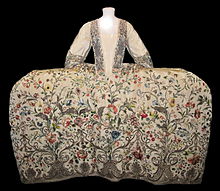- Mantua (clothing)
-
A mantua (from the French manteuil ) is an article of women's clothing worn in the late 17th century and 18th century. Originally a loose gown, the later mantua was an overgown or robe typically worn over stays, stomacher and a co-ordinating petticoat.
Contents
Evolution of the mantua
The earliest mantuas emerged in the late 17th century as a comfortable alternative to the boned bodices and separate skirts then widely worn.
The mantua featured elbow-length, cuffed sleeves, and the overskirt was typically drawn back over the hips to expose the petticoat beneath. In the earliest mantuas, the long trained skirt was allowed to trail. From about 1710, it became customary to pin up the train. The construction of the mantua was altered so that once the train was pinned up, the exposed reverse of the train showed the proper face of the fabric or embroidery. One of the earliest extant examples of this, dated to 1710–1720, is in the Victoria and Albert Museum's collections.[1]
By the mid-18th century, the mantua had become a formal fashion worn almost exclusively at Court. The draping of the overskirt became increasingly stylized, with the back panel of the train almost entirely concealed.[2][3]
Semantics
The origins of the term mantua to mean a robe are unclear. The garment may have been named after Mantua, in Italy, a centre of production for some of the expensive silks that would have been used to make up such garments. The term may also derive from manteau, the French term for a coat.
From this garment arose the term mantua-maker, an early term for a women's dressmaker.
Surviving examples
A mantua at the Victoria and Albert Museum, dated to 1744
Extant examples of the 17th century mantua are extremely scarce. Perhaps the only known extant adult-size example is an embroidered wool mantua and petticoat [4] in the Metropolitan Museum of Art's Costume Institute. A pattern taken from this mantua has been published by Norah Waugh.[5] The Institute also owns a mantua and petticoat in salmon pink bizarre silk dated to 1708.[6] Another early mantua, the silk dated to c. 1708–9 belongs to the Clive House Museum, Shrewsbury, a pattern for this mantua has been taken by Janet Arnold.[7]
Most mantuas preserved in museum collections are formal versions from the 18th century, intended for court dress.
See also
- 1650–1700 in fashion
- 1700–1750 in fashion
References
- ^ http://collections.vam.ac.uk/objectid/O13810
- ^ http://collections.vam.ac.uk/objectid/O78803
- ^ "Court dress [British] (C.I.65.13.1a-c)". In Heilbrunn Timeline of Art History. New York: The Metropolitan Museum of Art, 2000–. http://www.metmuseum.org/toah/hd/eudr/ho_C.I.65.13.1a-c.htm (October 2006)
- ^ Mantua [British] (33.54a,b)". In Heilbrunn Timeline of Art History. New York: The Metropolitan Museum of Art, 2000–. http://www.metmuseum.org/toah/hd/eudr/ho_33.54a,b.htm (October 2006)
- ^ Waugh, Norah. The cut of women's clothes 1600–1930. London: Faber, 1968. ISBN 0-571-08594-6
- ^ "Mantua [English] (1991.6.1a,b)". In Heilbrunn Timeline of Art History. New York: The Metropolitan Museum of Art, 2000–. http://www.metmuseum.org/toah/ho/09/euwb/ho_1991.6.1a,b.htm (October 2006)
- ^ Arnold, Janet Patterns of Fashion 1: Englishwomen's dresses and their construction, c.1660–1860.New ed. London:Macmillan 1977. ISBN 0-333-13606-3
Further reading
- Janet Arnold: Patterns of Fashion 1 (cut and construction of women's clothing, 1660–1860) Wace 1964, Macmillan 1972. (ISBN 0-89676-026-X)
External references
 Media related to Mantua (clothing) at Wikimedia CommonsCategories:
Media related to Mantua (clothing) at Wikimedia CommonsCategories:- French clothing
- Dresses
- Gowns
- Robes and cloaks
- History of clothing (Europe)
Wikimedia Foundation. 2010.


